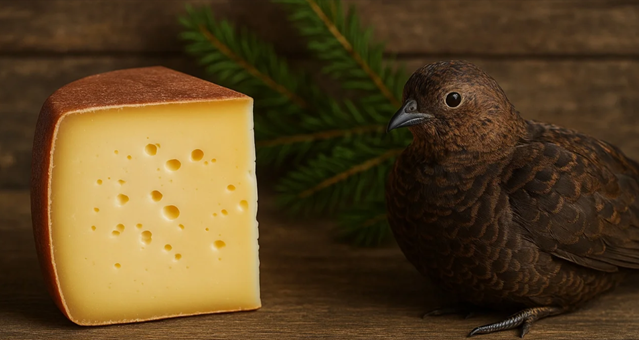Introduction to Grouse Cheese
Grouse Cheese Have you ever stumbled upon a cheese so unique it makes you rethink everything you know about dairy? Well, let me introduce you to Grouse Cheese—a lesser-known but incredibly delicious variety that’s quickly becoming a favorite among cheese lovers. In this detailed guide, we’ll explore everything you need to know about Grouse Cheese, from its rich history to the best ways to enjoy it.
What is Grouse Cheese?
Grouse Cheese is a unique, artisanal cheese that stands out for its creamy texture and complex flavor. Unlike your everyday cheddar or mozzarella, Grouse Cheese is made with a special touch that gives it a slightly gamey, earthy taste—some even say it’s like tasting the countryside.
History of Grouse Cheese
The origins of Grouse Cheese trace back to rustic European villages where farmers crafted cheese using traditional methods passed down through generations. It’s said that Grouse Cheese was often enjoyed during hunting feasts, especially when grouse birds were on the menu—hence the name.
The Origin of the Name
The term “Grouse” doesn’t come from the bird itself being part of the cheese (don’t worry, no birds involved!). Instead, the name pays homage to the areas where grouse birds are commonly found—wild, untamed places where this cheese’s natural ingredients thrive.
How Grouse Cheese is Made
Ingredients Used
Creating Grouse Cheese is both an art and a science. The main ingredients include:
-
Fresh cow, sheep, or goat milk
-
Rennet
-
Salt
-
Natural herbs (optional)
The Cheese-Making Process
The milk is first warmed and combined with rennet to form curds. After carefully cutting and stirring the curds, the mixture is pressed into molds. The cheese is then either enjoyed fresh or left to age, depending on the desired flavor profile.
Types of Grouse Cheese
Fresh Grouse Cheese
This is the mild, soft, and creamy version that’s perfect for spreading on warm bread.
Aged Grouse Cheese
With time, Grouse Cheese develops a harder texture and a bolder, more complex flavor that pairs well with wines and charcuterie.
Taste Profile of Grouse Cheese
So, what does Grouse Cheese actually taste like? Imagine a creamy, nutty base with subtle earthy tones that almost remind you of a walk through a pine forest. Aged Grouse Cheese can have a stronger, slightly tangy finish, while fresh varieties remain light and smooth.
Nutritional Value of Grouse Cheese
Grouse Cheese is not just delicious—it’s also packed with nutritional benefits:
-
Protein-rich: Great for muscle repair
-
High in calcium: Supports bone health
-
Contains healthy fats: Offers sustained energy
-
Loaded with vitamins: Like Vitamin A and B12
Health Benefits of Grouse Cheese
-
Boosts Bone Health: Thanks to its calcium content.
-
Improves Digestion: Especially if it contains live cultures.
-
Great Source of Energy: Perfect for a mid-day snack.
-
Rich in Antioxidants: If herbs are used in its making.
How to Store Grouse Cheese Properly
To keep your Grouse Cheese fresh:
-
Wrap it in wax paper, then loosely in plastic.
-
Store in the cheese drawer or a sealed container in the fridge.
-
Avoid freezing—this can ruin the texture.
Best Ways to Enjoy Grouse Cheese
Pairing with Wines
Aged Grouse Cheese pairs beautifully with bold reds like Cabernet Sauvignon or a crisp white like Sauvignon Blanc.
Serving with Crackers and Fruits
Think pears, grapes, or even figs. The sweet fruit balances the earthy cheese.
Using in Recipes
Melt it on toast, crumble it into a salad, or stir it into warm pasta—the options are endless.
Popular Recipes Featuring Grouse Cheese
Grouse Cheese Salad
Mix fresh greens, roasted walnuts, sliced pears, and crumbled Grouse Cheese for a refreshing bite.
Grouse Cheese Pasta
Toss cooked pasta with sautéed mushrooms, garlic, and melted Grouse Cheese for a creamy, rich dish.
Grouse Cheese Toast
Layer Grouse Cheese on crusty bread, add a drizzle of honey, and grill to perfection.
Why Grouse Cheese is Gaining Popularity
With people increasingly looking for artisanal, unique foods, Grouse Cheese is stepping into the spotlight. Its rich taste, flexible usage, and old-world charm make it a perfect choice for modern food lovers.
Where to Buy Authentic Grouse Cheese
You can find Grouse Cheese in specialty cheese shops, gourmet food markets, and select online stores. Always look for labels that indicate artisanal or small-batch production to get the best quality.
Conclusion
Grouse Cheese might not yet be a household name, but it’s well on its way. Its distinctive flavor, health benefits, and versatile use make it a cheese worth adding to your culinary collection. Whether you’re a cheese connoisseur or a curious foodie, Grouse Cheese offers a rich, gourmet experience that’s hard to forget.
FAQs
1. What is the shelf life of Grouse Cheese?
Fresh Grouse Cheese lasts about 1-2 weeks in the fridge, while aged varieties can last up to 6 months if stored properly.
2. Can lactose-intolerant people eat Grouse Cheese?
Some aged Grouse Cheeses contain lower levels of lactose, but it’s best to check the label or consult with the producer.
3. How do you know if Grouse Cheese has gone bad?
If it develops a strong ammonia smell, unusual mold, or an overly slimy texture, it’s time to toss it.
4. Is Grouse Cheese expensive?
It can be on the pricier side, especially if you’re buying small-batch, aged varieties, but many say it’s worth every penny.
5. Can Grouse Cheese be made at home?
Yes! With some patience, the right ingredients, and careful attention to hygiene, you can craft your own Grouse Cheese in your kitchen.

